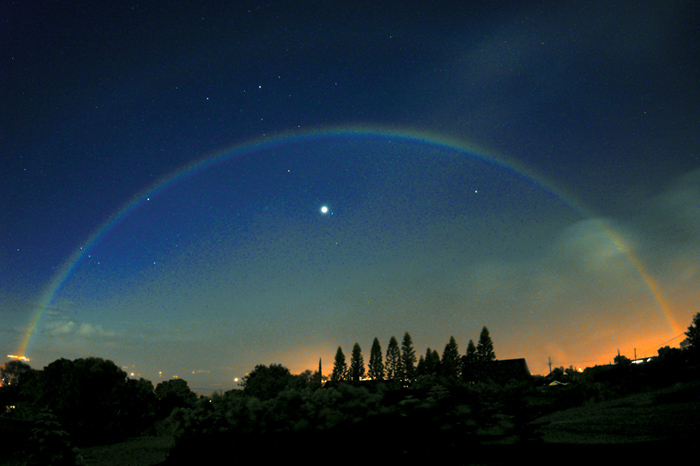
Key Takeaways:
- Lunar rainbows (moonbows) are significantly rarer than solar rainbows, occurring less than 10% as frequently.
- Moonbow formation requires the same conditions as solar rainbows (bright light source, rain, spherical raindrops), with the added constraint of requiring a Full Moon, limiting visibility to approximately 3 days around this lunar phase.
- Optimal moonbow viewing necessitates a low lunar altitude, a dark sky during evening twilight, and preferably summer months in middle latitudes for a longer viewing window.
- While moonbows possess color, the dim light often renders them imperceptible to the human eye, though photographic capture readily reveals their chromatic nature.
Lunar rainbows – moonbows – occur less than 10 percent as often as normal rainbows. Moonbows need a few additional conditions to form, which is why they’re so rare.
Although well known, rainbows themselves are not common – most places see fewer than six in a year. Locations with frequent, brief showers mixed with clear skies and bright sunshine see many more. The Isle of Skye on Scotland’s west coast and Hawaii are both places with frequent rainbows.
To make a rainbow, we need bright sunshine and a screen of rain opposite the Sun, but even that’s not enough. Both rainbows and moonbows need almost perfectly spherical raindrops – distortions of only 1 percent are sufficient to prevent a bow’s appearance.
Also, the light source must be at the right altitude. Rainbows and moonbows are centered directly opposite the Sun or Moon. The higher the light source’s altitude, the lower the bow’s arc. So, the Sun or Moon must be low enough that their bows form above the horizon.
However, moonbows need something more. While lunar rainbows form in exactly the same way as with the Sun, the Moon is bright enough to make visible moonbows only for about 3 days around Full Moon.
Moonbows are faint and must be viewed against a dark sky near the end of evening twilight. If you wait too long, the Moon will rise so high that any moonbow it creates lies below the horizon.
In middle latitudes, the Full Moon is best placed for moonbows in summer, when it spends more time low in the sky. In other seasons, the window of opportunity for catching a moonbow may last only an hour.
In showery weather, always look for a pale moonbow when the Moon is low and bright. A moonbow actually is colored like its daytime counterpart, but its light is mostly too dim to activate the color sensors in our eyes. A camera mounted on a tripod will capture the colors easily, but our eyes and brain alone are all that are needed to experience the wonder of the Moon’s own rainbow. – LES COWLEY, NORFOLK, ENGLAND









